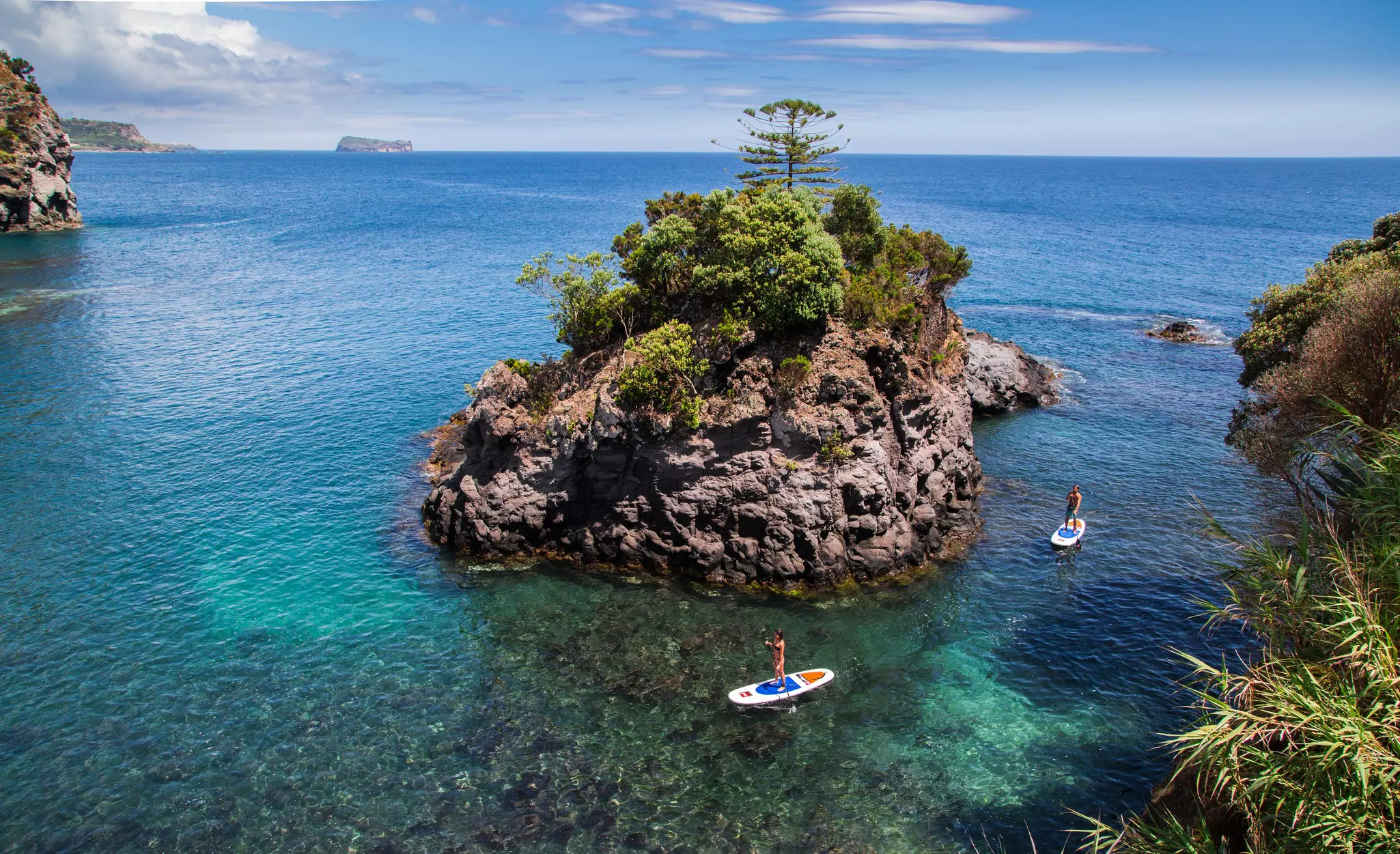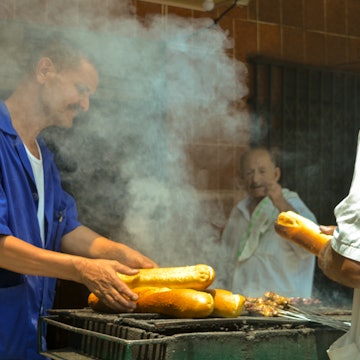
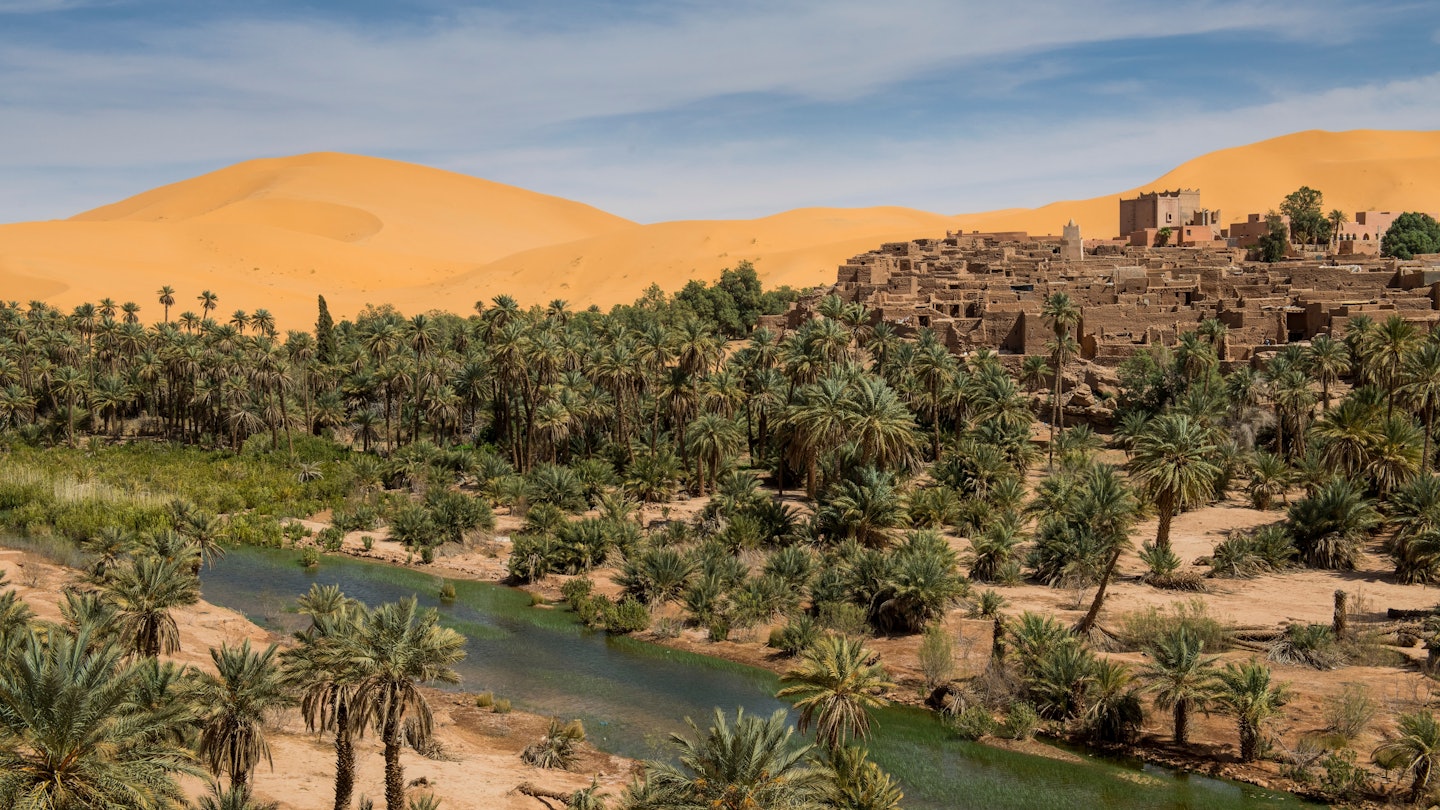
Taghit. robertharding/Shutterstock
If you've ever imagined sand dunes and a palm-fringed oasis, you were probably dreaming of the Algerian Sahara. No country contains more of the Sahara, the world's largest dry desert, than Algeria. Ancient river valleys carved from sand seas border isolated, misshapen mountains adorned with galleries of mysterious rock art from the time before the Sahara was a desert.
The Algerian Sahara is also the home of the Tuareg people, a formerly semi-nomadic community and the region's longest-standing inhabitants. Whether guiding travelers or herding camels and livestock around villages far from the world's noise, the Tuareg will be a soulful presence throughout your journey here.
But a trip to the Algerian Sahara requires careful planning. Visas need ample consideration and you'll need to be selective when determining the scope of your itinerary. You'll also need to travel as part of an organized tour, be it a camel expedition or by 4WD. Wherever and however you go, you’ll experience one of the world’s last truly wild places.

When should I go to the Algerian Sahara?
Conditions are at their best from October or, better still, November until March or April, with mild days and cool nights. A typical December day in Tamanrasset reaches around 21°C (70°F), with lows dropping to around 6°C (42°F) overnight. The peak time for tourists is in December and January, when Saharan trails can be surprisingly busy, but a trip in November or February can be just as rewarding, with barely any other travelers around.
From May until September, it’s simply too hot to visit the Sahara. Although it’s a dry heat, daytime temperatures during these months regularly exceed 40°C (104°F), and most tour operators close down until temperatures become bearable.
Djanet’s Sebiba Festival is in June or early July – it’s a great time to be in town, with people in the Tuareg community wearing traditional dress and reenacting an ancient battle. Spring (March to May) is another fine time to visit as three festivals enliven the region: the Ghardaïa Carpet Festival (Fête du Tapis) in March promises traditional music, food stalls and competitions for the best carpets; Le Tafsit in Tamanrasset has its camel races in April; and at the Fête de la Fantasia in late spring, horsemen parade through the streets of Ghardaïa. Check with your tour operator about the event calendar when you are making arrangements.
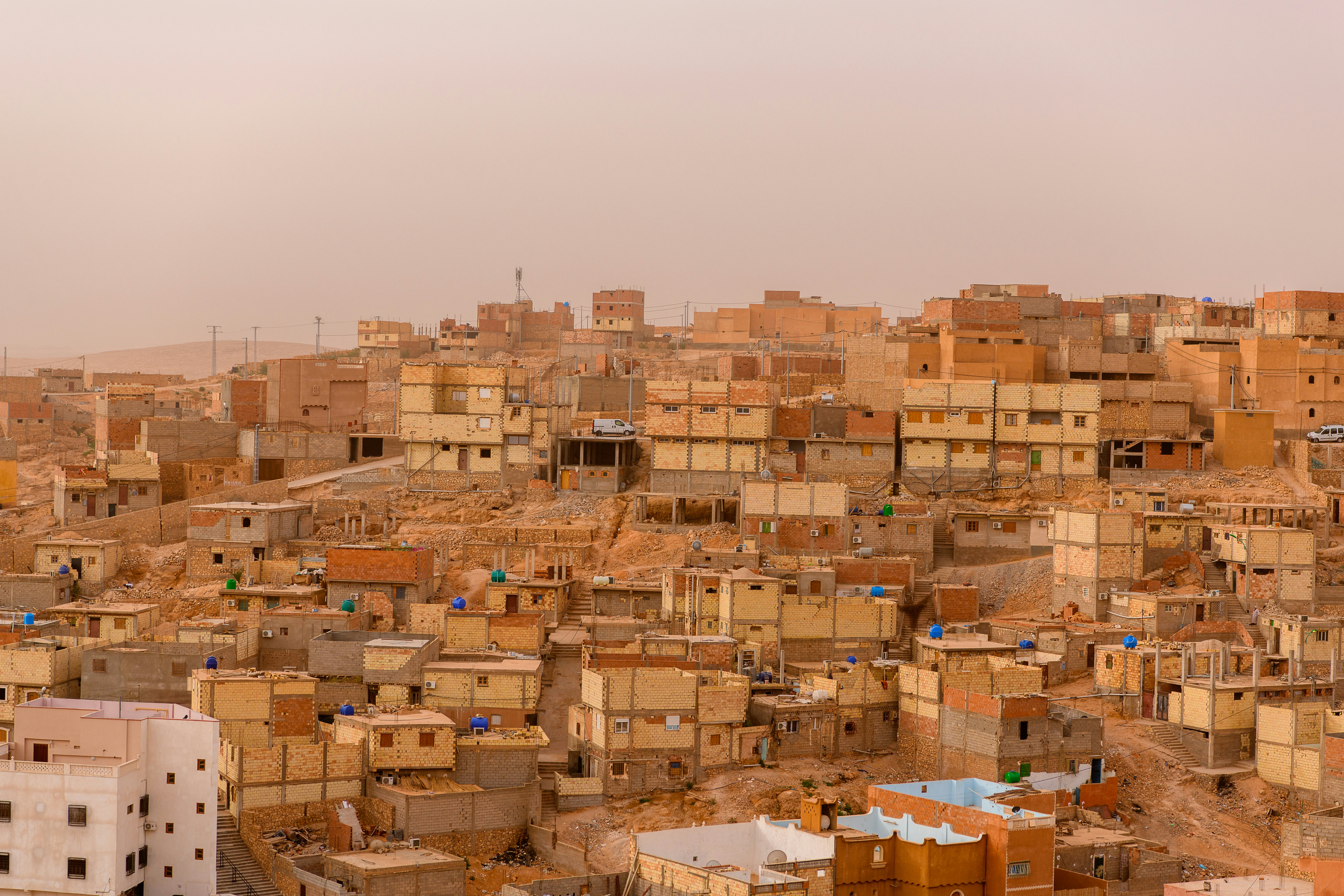
How much time should I spend in the Algerian Sahara?
The simple answer is that you should stay as long as you can – the longer you are here, the greater the rewards.
There are three main areas to build an itinerary around. For deep desert immersion, Djanet deserves at least a week, allowing you to visit the northern Tassili N’Ajjer, Tadrart or the Sefar Plateau, and perhaps two of those spots. Tamanrasset and nearby Assekrem and Ilmane deserve three or four days – you could combine both the Djanet and Tamanrasset areas on a fabulous 10-day trip.
Further north, Ghardaïa and the M’Zab Valley are the main focal points, but you could extend a visit here to El Oued, Timimoun and beyond. Ideally spend four or five days in Ghardaïa or up to two weeks across the entire area, depending on how far you roam.
Is it easy to get in and around the Algerian Sahara?
Reaching the Algerian Sahara usually means flying from Algiers into Djanet, Tamanrasset, Ghardaïa or one of the other oasis towns. At the airport, you’ll be met by a guide, who works for the tour operator that organized your trip, and from that point on, you’ll be under your guide's care and driven around in a 4WD vehicle, although some tours involve walking and even riding a camel.
If your tour includes different regions, it’s possible to fly between the different Saharan towns (Djanet to Tamanrasset, for example).
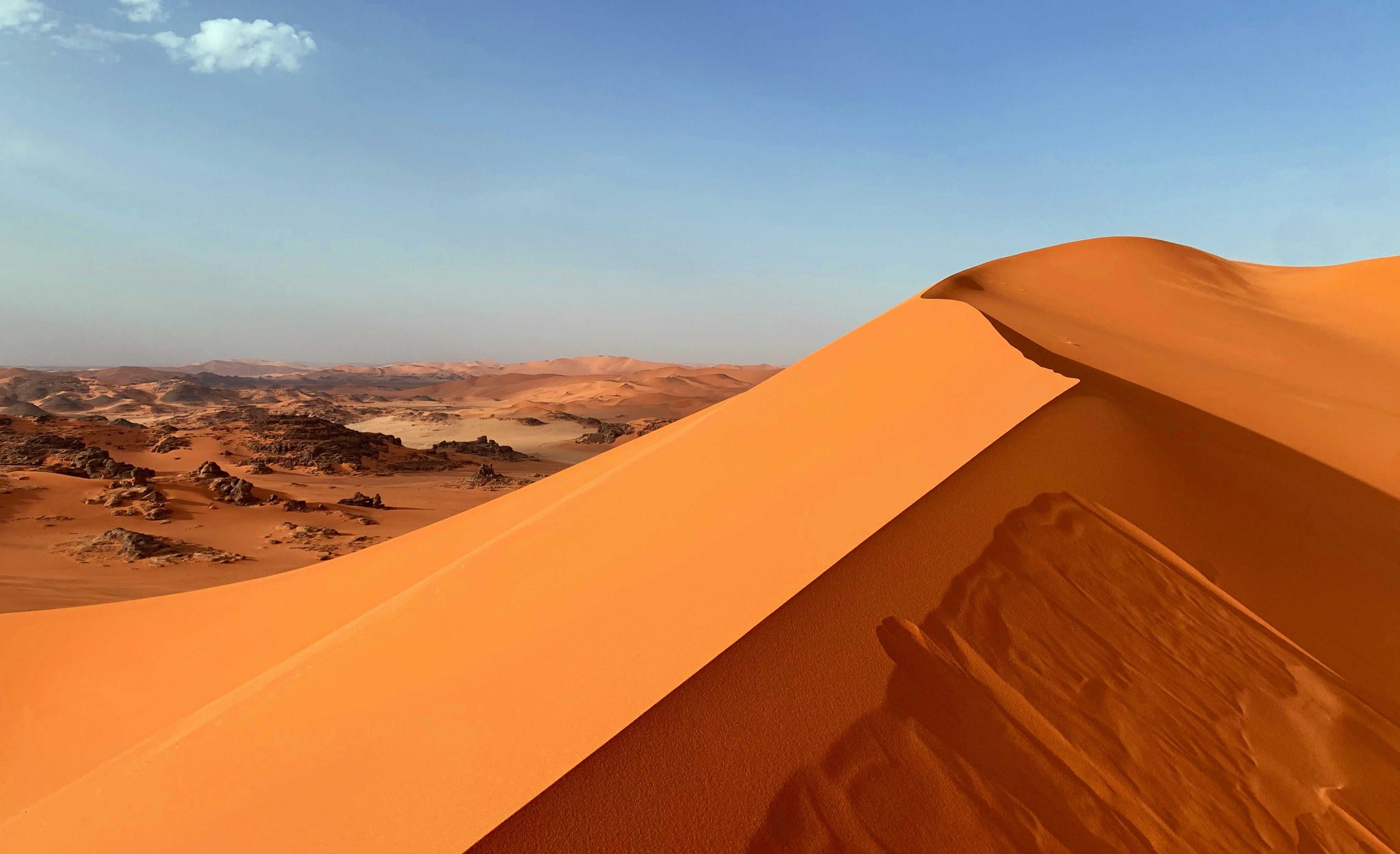
Top things to do in the Algerian Sahara
Exploration of the Algerian Sahara radiates from a few gateway towns: Tamanrasset, Djanet and Ghardaïa. Each has its own appeal, but the real adventure begins when you head toward the far horizon. Most attractions in the Algerian Sahara fall within the boundaries of Ahaggar National Park (near Tamanrasset) and Tassili N’Ajjer National Park (close to Djanet), although you’re unlikely to realize when you enter or leave either park.
Marvel at the rock formations at Assekrem and Ilmane
The Atakor plateau is one of the Sahara’s most astonishing sights. This high realm of sun-blistered mountains and eroded volcanoes is populated by otherworldly rocky outcrops and high summits. Its centerpiece is Assekrem, the best part of a day’s drive northeast of Tamanrasset. Here, travelers sleep at a high-altitude refuge before climbing to the simple hermitage built by the legendary French Trappist priest Charles de Foucauld; three priests still live at the site. The sunsets are among the most photogenic in the Sahara – all of the numerous vantage points are utterly spellbinding.
Northeast of Tamanrasset, Ilmane is a quieter world of glorious rock formations and remote valleys. The main sand valley is home to a makeshift desert mosque with unrivaled views of Pic Ilmane, a soaring volcanic plug that dominates the region close to the village of Terhenanet. A road (and I use the term loosely) connects Ilmane to Assekrem, but even experienced local drivers consider some sections along a cliff face to be dangerous and prefer the longer route via Tamanrasset.
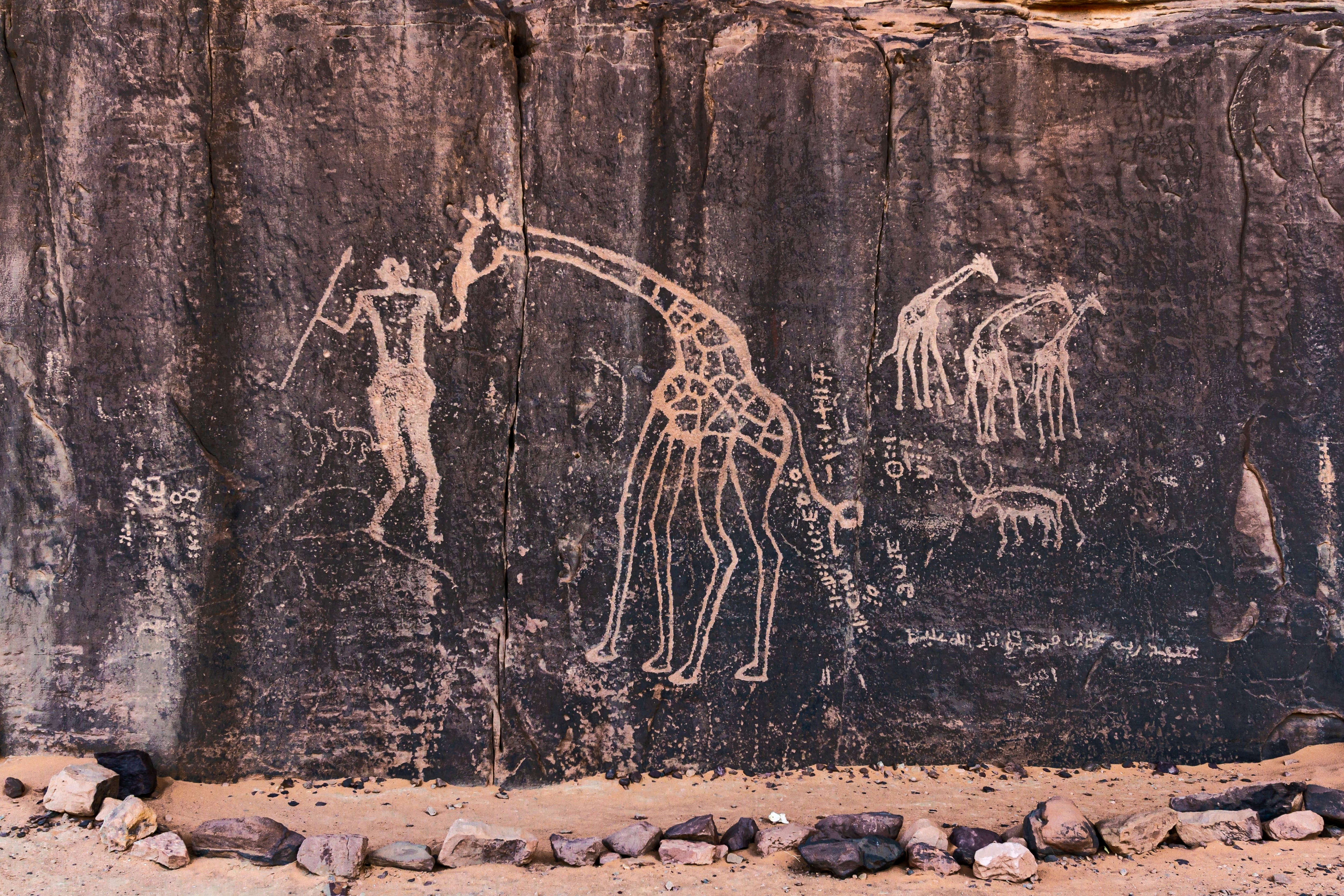
Seek out ancient art in the Tassili N’Ajjer
Inscribed on UNESCO’s World Heritage List, the mountain range of Tassili N’Ajjer is a special place. The Tassili shadow the main road north out of Djanet for hundreds of kilometers, and the valleys that disappear into the massif’s inner reaches are filled with millennia-old rock art. Appearing as both engravings and ochre paintings, these ancient artworks chart the natural history of the Sahara, telling the story of its transformation from a world of savannah grasslands, forests and lakes, when elephants, giraffes and big cats roamed the area, to the desert we know today.
The backdrop to this stirring story is a remarkable portfolio of scenic valleys and ranges. Highlights include the deep-water well of Oued Essendilene, the peerless panoramas of Tikobawen, the stellar rock engravings of Tin Taghirt and the incredible views from Idaren, a lookout close to the Tuareg village of Ihrir. Closer to Djanet, the rock art of Tim Ghaz, Taghin and the larger-than-life Crying Cows of Tegharghart, and the hallucinatory landscapes of Adaeeg are all worth lingering over.
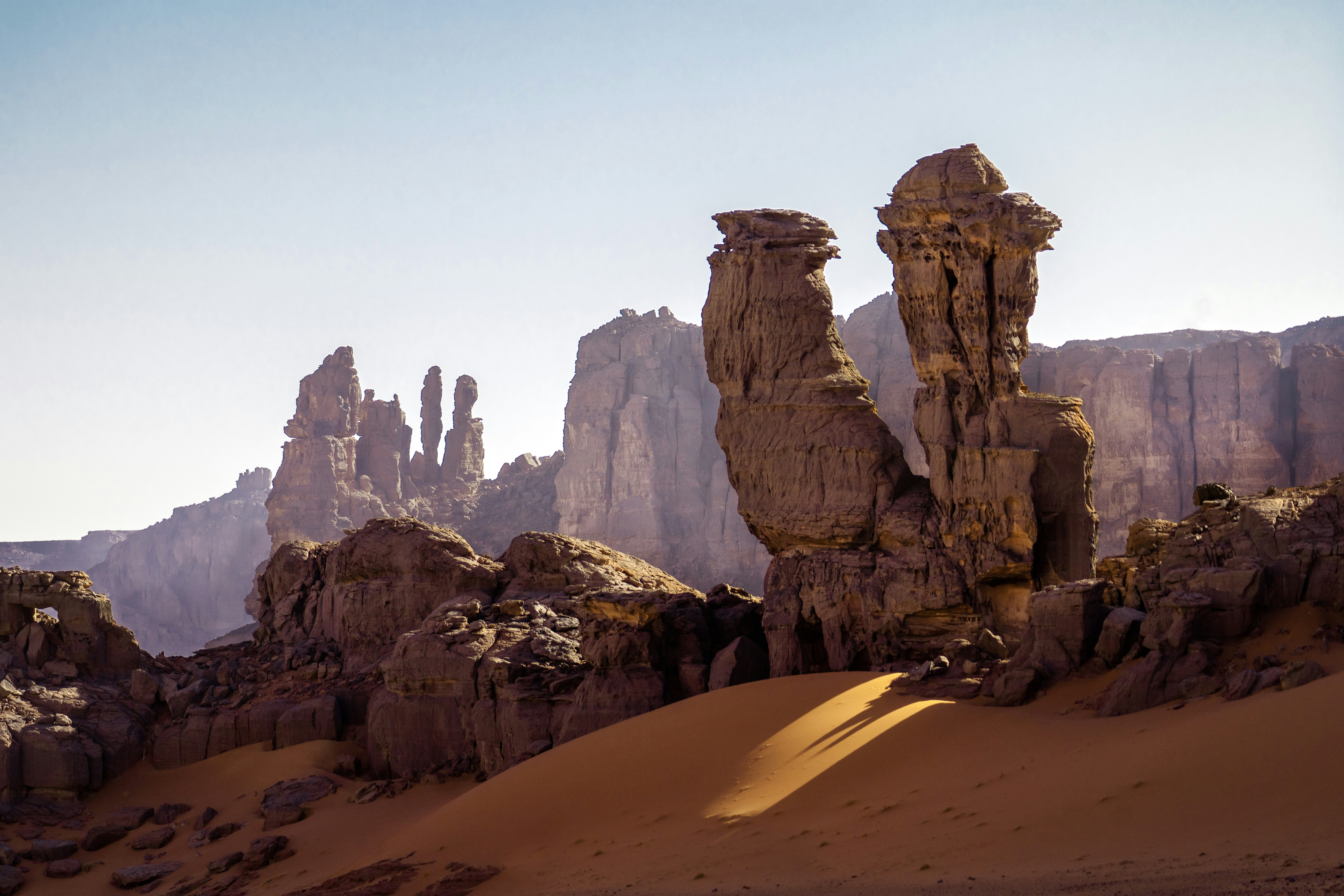
Unplug in the Tadrart plateau
Technically a southern extension of the Tassili N’Ajjer, the Tadrart plateau is the Sahara at its most isolated and rewarding. The full experience of red sand dunes, stunning rock art and landscapes that range from mountain ridges that look like the ramparts of a forgotten desert kingdom to natural arches and other perspective-altering shapes involves a five-day expedition out of Djanet. Throughout, you’ll sleep under the stars, eat around a campfire and generally find yourself exclaiming with wonder at the beauty of the land.
Choose an adventurous activity in El Oued
Known as the City of a Thousand Domes, El Oued has a fabulous souk, where you can shop for carpets and enjoy a morning dubarra, a spicy soup usually available around the souk’s perimeter. Don’t miss the chance to go on an overnight desert excursion into Algeria’s (and perhaps the Sahara’s) largest sand sea, where you’ll sleep under an astonishing spray of stars. Other possibilities include sand boarding, quad biking and camel trips. Back in town, take in the view from the Grand Hôtel du Souf.
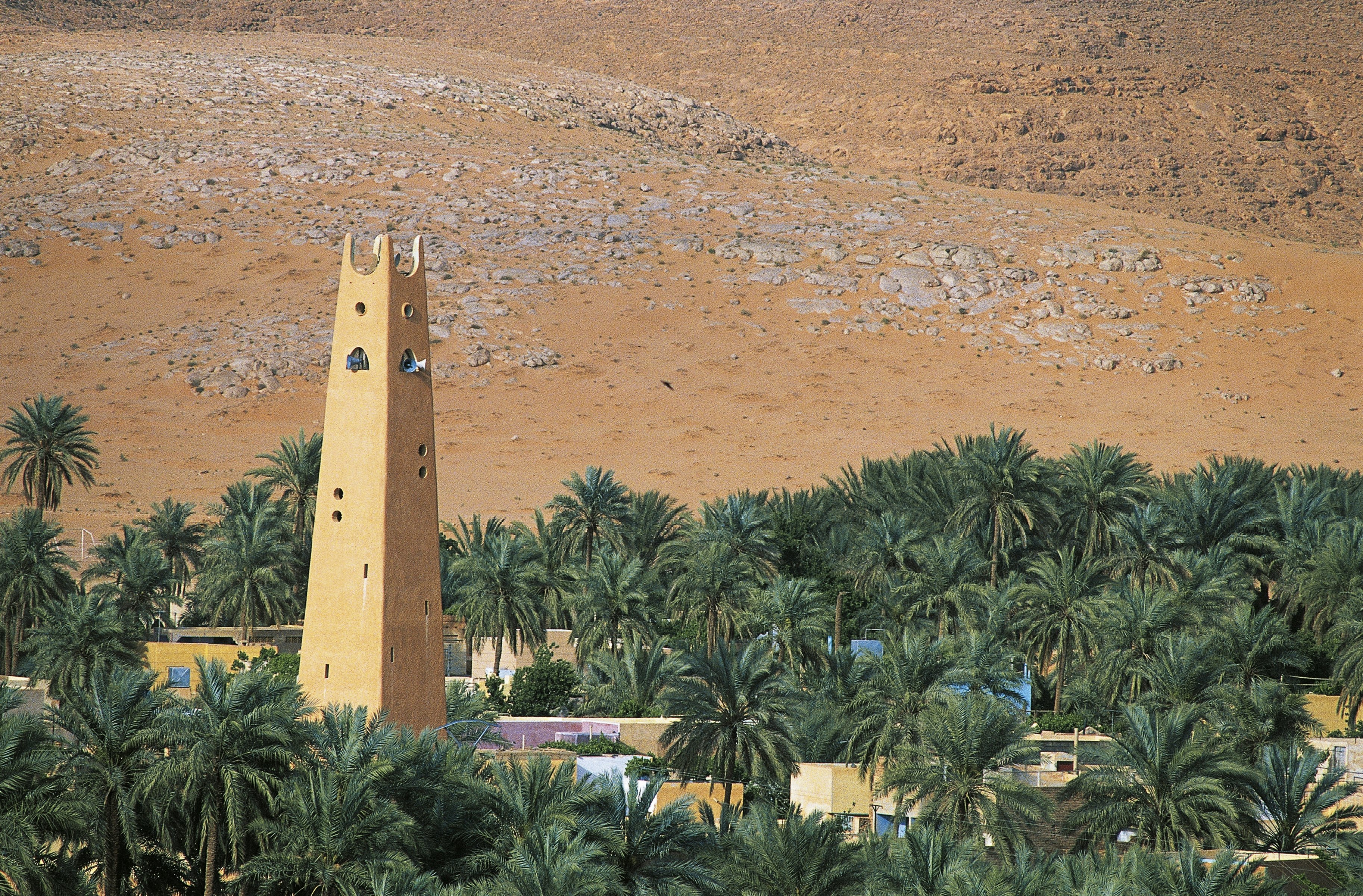
Ease into oasis culture in Ghardaïa and the M’Zab Valley
Of all the oasis and caravan towns in the Algerian Sahara, Ghardaïa and the neighbouring fortress villages of the M'Zab Valley most overshadow the desert that surrounds them. A last stronghold of the Ibadi sect of Islam since the 11th century, the valley is awash with palm trees and ruled by ancient mud settlements, each of which climbs to a pyramid-like summit. Stay in a traditional home in Beni Isguen, take in the glorious view from the terrace of the Belvedere Hotel in Ghardaïa or wander the tangle of alleyways in timeless Bou Noura. Ghardaïa’s main souk is a gem; come and go from the market square as you shop for carpets or find yourself spellbound by the call to prayer at sunset from one of the valley’s mosques. These are places to slow down to a desert rhythm and soak up a Sahara unchanged by centuries.
Hike to the rock paintings on the Sefar Plateau
Rising above Djanet, the Sefar Plateau is a lost world, accessible only to those who hike half a day up the plateau. Once at altitude, you’ll spend a day (or a week or anywhere in between) hiking through a valley filled with 2000-year-old cypress trees, drawing near mind-bending stone pillars that resemble petrified cities masquerading as mountains and pondering finely rendered rock art of everything from ancient battles to giraffes and other animals. Sefar has two rock engravings, including one known as the Great God of Sefar, that no one can explain. Evidence of alien life or a fertile ancient imagination? You decide.

Explore the Algerian Sahara's remote west
Nowhere in Algeria receives many tourists, but out west in the Algerian Sahara, you might be the only one here. Each of the oasis towns in these parts crouches precariously on the edge of a vast sea of sand, at once a refuge from the awful beauty of sand and sky and a center of culture and activity.
Timimoun is the Saharan oasis of childhood imaginings, as rust red as the sands that surround it. Taghit is awaiting a day when travelers learn of its charms – you can quad bike, ride camels and even kayak through the oasis. Beni Abbès is steeped in history, not to mention a candidate for the most beautiful oasis town in the entirety of the Algerian Sahara. And Aïn Sefra (connected to Taghit by the N68 and CW12, one of the more spectacular drives in the Sahara) is the last resting place of legendary 19th-century writer Isabelle Eberhardt, who died here in a flash flood at age 27. At every stop, the perfect ridgelines of towering dunes, magical at sunrise and sunset, watch over your journey.
My favorite thing to do in the Algerian Sahara
While everyone else makes a pilgrimage to Assekrem, I prefer the valley from Terhenanet to Ilmane. The desert mosque, the rock face that looks like it has shattered to its core, the quiet that descends as the sun goes down; when exploring this terrain in the company of Tuareg guides, hearing their stories around a campfire and searching for echoes of wild creatures in the rock art of Tadmart Tan Afella, I never want to leave.
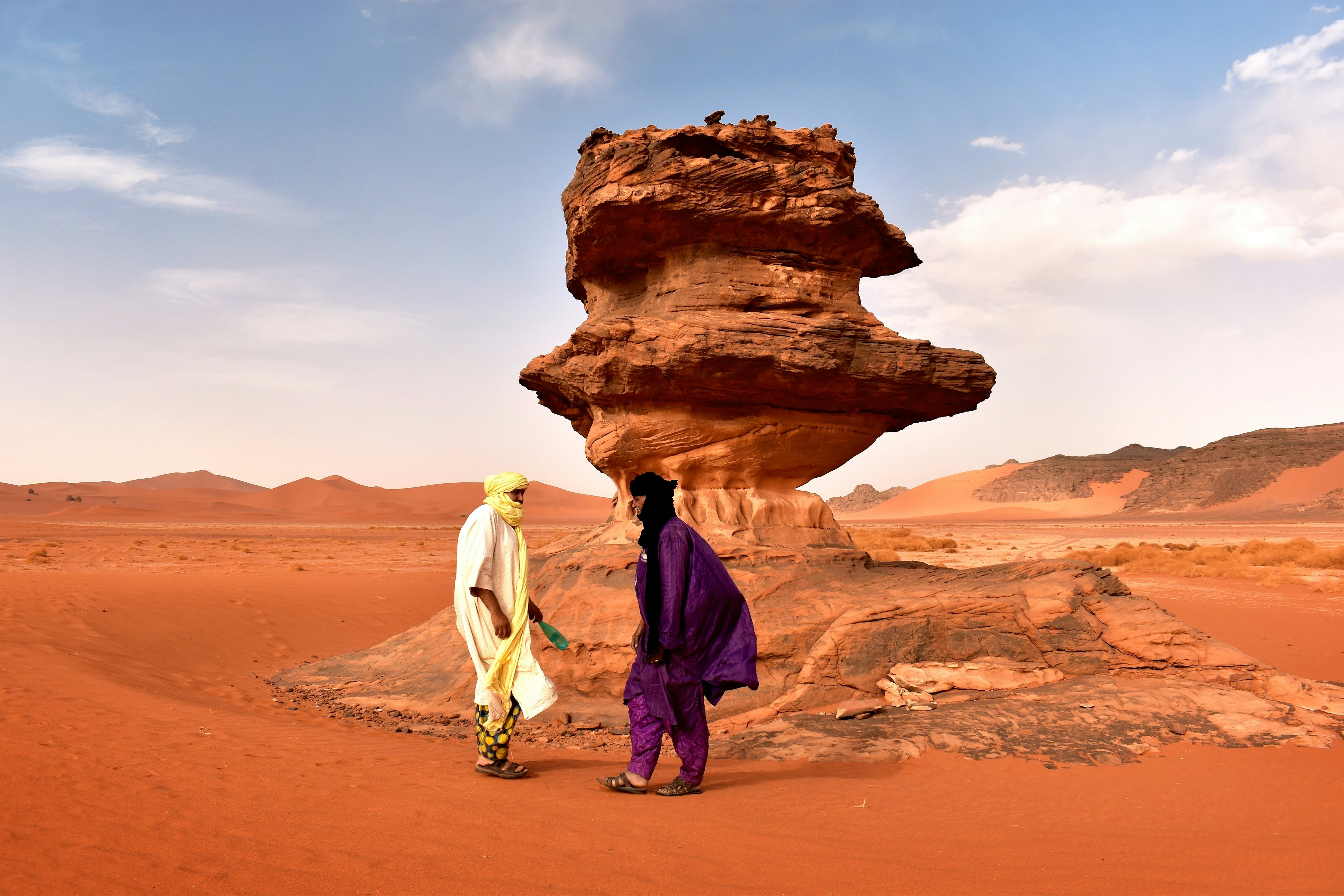
How much money do I need for the Algerian Sahara?
In Algeria, cash is king, and credit cards can be used only very rarely. Change money through your guide or tour operator – the rate should be at least twice what you get at a bank.
It’s difficult to travel to the Algerian Sahara on a tight budget, although it’s easier in the central towns of the northern Sahara, such as Ghardaïa, El Oued or Timimoun, where independent travel is possible.
For all destinations out of Tamanrasset and Djanet, and including these two towns, you must travel on an organized tour. While this can be expensive, once you’ve paid for the tour (which should include all transportation, accommodations, a guide, a driver and food), there’s very little else to spend your money on. And while desert travel can be expensive, traveling in a group can bring costs down, and fuel is generally cheaper than in other countries.
It’s worth bringing a little extra cash for tips (around US$10 per person per day for your guide and driver) and spending money (for souvenirs, drinks) while in towns.
Night in a hotel in Djanet or Tamanrasset: US$10–50
One-way flight from Algiers to Oran: US$80
Three-course meal in a tourist restaurant: US$15
Local guide per person per day in Ghardaïa: US$20–40
National park entry: free
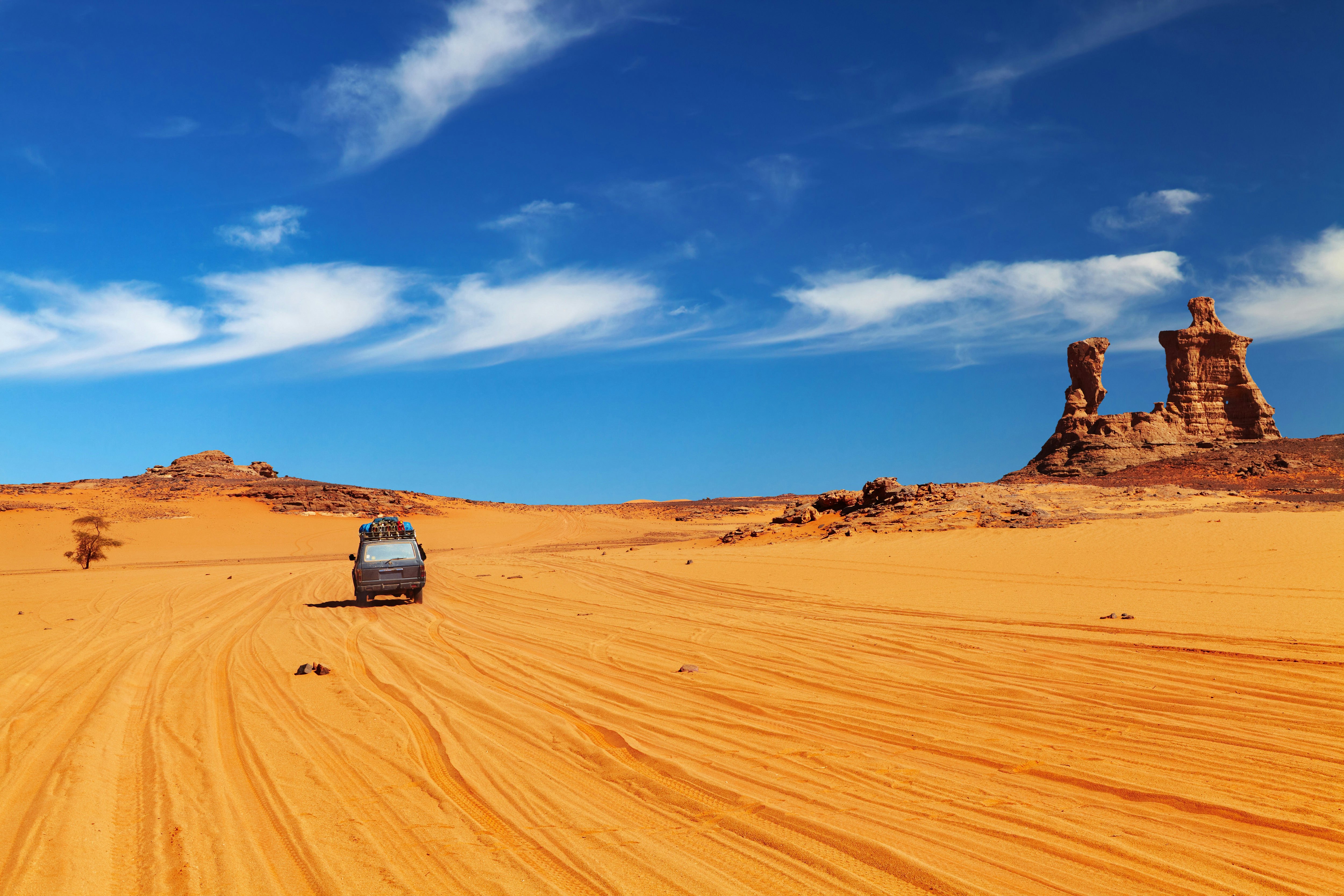
What type of trip can I take to the Algerian Sahara?
There are almost as many tours and itineraries as there are operators in the Algerian Sahara, but it’s how you travel, not just the route, that you need to choose.
The standard Saharan expedition involves driving in a 4WD vehicle from one beautiful campsite or village to the next. You’ll stop at rock art sites, villages and scenic locations along the way, including a stop for lunch. You’ll eat like royalty as your cook conjures up varied meals while you admire the view or explore your surroundings. A 4WD expedition is the best way to see as much of the Algerian Sahara as you can in a short time frame.
A variation on the theme is the camel expedition. This might mean riding the camel or walking alongside it while it carries your baggage. You won’t be able to range as far on a camel tour as you can in 4WD, but you’ll travel more sustainably and free of engine noise – it’s a wonderful way to experience the Sahara.
It is also possible to drive your own 4WD, which usually means putting it on a ferry from Europe and driving through Algeria to the Sahara, which can take days. Once you arrive in Algeria’s south, you’ll still need to travel in the company of a guide.
How do I get a visa for Algeria?
There are two ways to get an Algerian visa: in advance from an Algerian embassy or on arrival.
To obtain a visa in advance, apply to the Algerian embassy in your country of residence or nationality. It involves filling out an online form and sending in your original passport, two recent passport photos, a prepaid return envelope, proof of purchase of airline tickets to and from Algeria, proof of travel insurance and an itinerary. Visa fees (around US$80) can usually be paid online. Get started at least six weeks before you plan to board a plane for Algeria.
If all or part of your trip is with a tour operator (compulsory if you're visiting the country's south), you can obtain your visa on arrival in Algiers. The tour operator will guide you through the process; once they have your visa approval, they should send you a boarding authorization. To avoid difficulties with the airline (particularly Air France), carry a letter from the tour operator and a copy of your itinerary on the tour company's letterhead, as well as proof of onward travel.
Getting a visa through an embassy tends to be cheaper than getting one on arrival, and you should sail quickly through immigration. Getting one on arrival usually takes around two hours.
What’s a good tour operator in the Algerian Sahara?
A professional tour operator will organize a Saharan trip of a lifetime. We recommend Duneya Tours, Elegant Algeria, Expert Algeria and Fancy Algeria.


